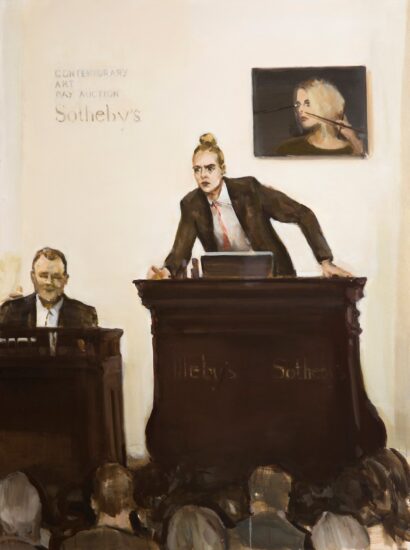Eglė Karpavičiūtė

Eglė Karpavičiūtė, Selling myself, oil on canvas, 160×120, 2017. Image Courtesy to the artist and The Rooster Gallery
Eglė Karpavičiūtė (born 1984) treats painting as a thought process. The object of her reflections is, first and foremost, the discourse on painting which also includes the issue of the “death of painting”. She turns the medium of painting into a powerful virus, almost as a reflective filter through which other forms of art, important works, and artists may be viewed. Karpavičiūtė uses the methods of painting characteristic of Gerhard Richter and Luc Tuymans, who explored the theme of painting in their work and exhibitions, and transposes portraits and ready-mades (by Marcel Duchamp, Francis Bacon, Joseph Beuys, Damien Hirst, and others), onto the canvas.
However, rather than the actual appearance of these artists in Karpavičiūtė’s work, the most important aspect is the distanced critical gaze, which emerges between the audience and the work, between the history of art and the contemporary artist, and between the discourse of painting and the painter who engages in it. The artist’s works reveal her thoughtful and incisive relationship with the art world, and particularly with the medium of painting. She does this by choosing the language of the ephemeral, disappearing image-within-an-image. In her most recent works, she equally reflects, both wittily and aptly, on figures from contemporary art, pop culture, and the elite. It is the artist’s attempt to write her own history of contemporary art, and position herself within it, unfolding in exceptionally interesting ways in the works where she uses her own image – self-portraiture, which is both a reference to the fragility of her position and an opportunity to control how she is represented.
Eglė Karpavičiūtė was awarded the Young Painter Prize in 2012 and was the finalist in the Sovereign European Art Prize exhibition in Istanbul in 2011. In 2015, the artist won two international art prizes – Premio Combat Prize 2015 and Donkey Art Prize. Her works have been exhibited at the National Gallery of Art and the Contemporary Art Centre in Vilnius, KUMU Art Museum in Tallinn, Kunsthaus Pasquart in Switzerland, and at various international art fairs in Tel Aviv, Brussels, Paris, London, Dubai, and elsewhere.
The artist is represented by The Rooster Gallery (Vilnius): www.roostergallery.eu